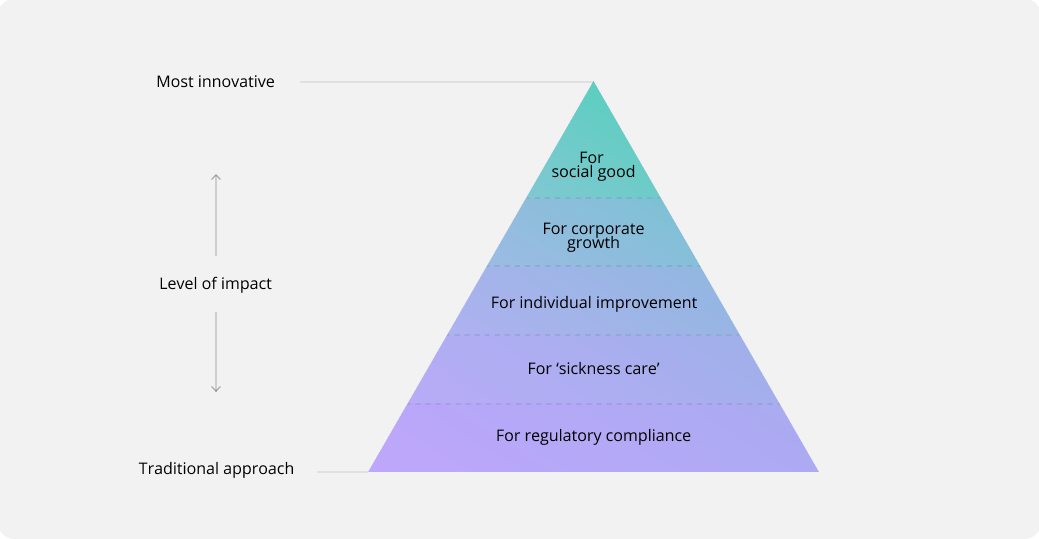17/6 By Rianne Meijerman, Head of User Onboarding & New Business Development
SUSTAINABLE EMPLOYABILITY: HOW TO BUILD A CULTURE THAT NURTURES EMPLOYEE HEALTH AND WELLBEING
As organizations prepare for a post-pandemic work environment, employee health and wellbeing has become one of their top strategic priorities. In a world where companies are increasingly judged by their contributions to the community at large, a healthy workforce — demonstrated by a commitment to people’s health and wellbeing — is a vital part of what it takes to build a sustainable, high-growth company.

What's in this blog:
- Health and wellbeing challenges for organizations in 2021
- Sustainable employability: the business imperative of a healthy and productive workforce
- Trends in corporate health and wellbeing programs in 2021
- The link between health, wellbeing and performance
- Top 5 tips to build a culture of health and wellbeing in your organization
Health and wellbeing challenges for organizations in 2021
After a year that has radically reshaped the way people do their jobs, employees in the Netherlands are slowly returning to office life and seeing their colleagues face-to-face again.
But the world of work looks very different today, compared with what we knew before the pandemic.
Mental health, stress and anxiety
In recent years, more than 60% of sick-leave cases in the Netherlands have been attributed to stress and burnout.
And now, because of the impact of Covid, employees are facing a further risk to their mental health.
Surveys show that while most employees have appreciated the greater flexibility offered by home working, others have experienced elevated levels of stress and anxiety as the blurring of home life and work life takes a toll on their mental health.
According to a recent McKinsey report, 46% of employees in Europe say they are feeling a moderate to high degree of burnout in their current role. In the same report, almost half of employees say they would like to see their organizations pay more attention to the topic of wellbeing, and communicate better around policies, expectations and approaches for new ways of working.
Female employees, in particular, seem to be feeling the impact of the current home working arrangements with tighter working hours and increased family care responsibilities.
Isolated at home, employees have also been missing the social aspect of their workplace.
Around 44% of respondents to the McKinsey survey said they are afraid remote working is leading to loss of community and collaboration with colleagues. Most employees would prefer to see a ‘hybrid’ model where they can work 2-3 days of the week from the office.
Physical health
Apart from mental health, the pandemic has had a definite impact on people’s physical health. With Covid-19 having already sickened more than one in five Dutch people, many sectors of the economy have seen workplace absenteeism climb to levels rarely seen this century.
Absenteeism peaked at 4.9 percent in the fourth quarter of 2020 and is likely to remain at elevated levels for the rest of 2021.
It remains to be seen how much of these numbers can be attributed directly to Covid; either way, the long-term consequences of a once-in-a-generation pandemic will require organizations to provide extra care and attention to the welfare and wellbeing of their people.
Proactive health approaches
Looking ahead, as they renew their health and wellbeing strategies, it is vital for companies to break the stigma around ill health in the workplace.
If organizations sweep people’s health issues under the carpet, this only causes illnesses to grow worse later on, leading to employees burning out.
Amid the complex dynamics of the world in 2021, organizations can no longer afford to treat employee wellbeing as a short-term initiative.
Organizations need multi-year, ‘360 degree’ programs to address their workforce health risks, as well as the associated risks surrounding talent retention, productivity and engagement.
Sustainable employability: the business imperative of a healthy and productive workforce
Vitality on the work floor is a huge challenge as staff cope with a return to office-based working or new hybrid home/office models.
According to Dutch national statistics, employee absenteeism has been a growing problem across all over the past five years. And the numbers have worsened since Covid broke out.

Graph: Annual absenteeism % among employers in the Netherlands, 2015-2020 (Source: CBS).
Viewed from a purely economic perspective, employee health is important because of its impact on business performance – and also on the bottom line.
Employers pay a heavy cost for the disruption caused when employees get sick: €400 is the average net daily loss for every staff member on sick leave, and the costs can be substantially higher when valued talent fall ill.
As you consider these numbers, you might be wondering if your organization can afford to invest in health checks for your entire employee population to mitigate the known risks. The more urgent question is, can you afford not to?
Trends in corporate health and wellbeing programs in 2021
The ongoing health crisis has turbo-boosted HR trends around employee health and wellbeing.
According to the latest research from the Top Employers Institute, 92% of leading organizations now see wellbeing as a top priority for their organizations, up from 83% in 2020. Employers are looking to invest resources in employees’ physical health, fitness, nutrition and stress management – which will help their organizations to reap the benefits of a more engaged, high-performing workforce.
A preventive approach

Graphic: While regulatory compliance is the basic foundation of any workplace healthcare program, the most innovative companies strive to benefit not only their people but also have an impact on the health of the communities they serve.
Since wellbeing has multiple facets (physical, emotional, social, financial and career), the most innovative companies are starting to look at it through the lens of prevention, defining wellbeing as part of their corporate social responsibility efforts to ensure the benefits are spread proportionally to the entire workforce and also to the community at large.
Beyond the narrow definition of wellbeing as ‘treatment of sickness’, organizations are starting to address the root causes of what makes people ill.
The new breed of corporate wellbeing programs cover topics such as mental health, physical health, fitness, nutrition, stress management and more.
The idea is that an employee should never feel powerless to control their own health. Clichéd as it sounds, prevention is better than cure.
A range of health checks for all employees

Organizations at the cutting edge of employee wellbeing have decided that good health is no longer a ‘benefit’ to be reserved for the selected few.
Whereas corporate health programs used to gear themselves solely to the needs of the most senior staff, nowadays it’s becoming much more common to have health programs available for employees of all ages, with a menu of differentiated programs catering to the employee’s type of role and scope of responsibility.
Because everyone’s health is different, corporate health and wellbeing programs can only succeed if they avoid one-size-fits-all approaches.
The link between health, wellbeing and performance
One of the biggest challenges for organizations in 2021 and beyond is to create a culture of high performance in a fast-changing work environment – making sure the foundation is laid to ensure employees have the energy to perform at their best.
Organizations that invest in employee health and wellbeing can expect to mitigate the costs and performance risks of poor productivity, absenteeism, stress, and burnout. But perhaps the most valuable effects of health and wellbeing is in improving the culture and performance of the organization.
Building a culture of health relies on similar methodologies needed to drive any kind of big change.
It starts with making the change effort a strategic priority – through leadership commitment and the allocation of resources. Then, it continues through the change curve with communication, employee engagement and follow-through on the commitments made.
Five tips to build a culture of health and wellbeing in your organization

1. Make it a strategic priority: plan the long-term change to your wellbeing strategy
Change does not happen overnight, and it certainly does not happen without a long-term plan. Your organization needs to set a wellbeing strategy tailored to the unique needs of your workforce, keeping in mind that everyone’s health is different.
Remember: shaping each employee’s health are a fusion of factors, including:
- The person’s environment (home life and work life)
- The employee’s lifestyle (e.g. diet and fitness)
- The employee’s biology (DNA and family health history).
If your corporate wellbeing vendor is only analyzing a small subset of these dimensions, your wellbeing program is likely to fail.
At Ancora, our team are passionate about taking a ‘360 degree’ approach to health. We have deep experience in designing bespoke corporate wellbeing programs rooted in science, while making sure they meet the unique needs of the organizations and people we serve.
2. Get leadership commitment to drive the change
You can only drive culture change if your employees see a passion for change percolating down from the top.
Among leading organizations, it is becoming commonplace to have at least one leader dedicated to coordinating wellbeing strategies at global level. This person may even be given the title of Chief Health Officer. His/her purpose is to ensure that people’s physical and mental health becomes a critical ingredient in the organization’s culture.
Related to that, it’s a good idea to recruit ‘ambassadors’ from different parts of the organization to be the catalysts for change.
3. Allocate sufficient resources to your wellbeing activities
Companywide health programs are not cheap but the long-term investment will certainly be worth it.
A good start is to consolidate all the scattered investments that take place today in different parts of your organization. Through localized HR programs, there may be a good deal of effort already being made that is not immediately transparent. Be sure to prioritize your investment based on a good understanding of the needs of your employees and so that you can measure the impact of your health and wellbeing activities.
To make sure health is not something that has to be negotiated or traded during the annual operating plan, many organizations are deciding to commit a percentage of their total global HR budget to a standardized employee health and wellbeing offering, while any extra resources may be diverted into the hands of local organizations to drive creative local activities for staff on the front line.
4. Communicate openly with employees, engage them in the change effort
As you embark on a new approach to wellbeing in your organization, it is crucial to be transparent with your employees about the rationale behind your change effort.
The new generation of corporate health programs such as Ancora’s recognize that ‘check ups’ alone are only one side of the coin when it comes to preventive health. To improve their health, employees will also have to act themselves. For example: making smart adjustments to their diet, infusing healthy habits into their daily routines, and recognizing the early warning signs of stress and burnout.
Relying on scientific data and personalized guidance, people can shape their own health journeys by proactively addressing their individual, lifestyle-related health risks.
But they must act. Good health does not happen by accident.
5. Measure your organization’s success
To successfully implement a new health and wellbeing strategy, you’ll want to have data that allows you to track your organization’s health status over time. As everybody will recognize, what gets measured gets acted upon. Be sure to hold your corporate health vendor accountable for providing the right set of metrics – and ensuring improvement where needed.

FINAL THOUGHTS
2020 was all about improvising solutions for employee health.
As a leading organization, your ambition in 2021 should be to make people’s health a permanent fixture of your culture to drive business performance. A key differentiator of your employer branding, it will demonstrate you have a passion for the health, wellbeing and performance of your greatest asset: your people.
As one of Europe’s leading preventive health specialists, Ancora offers a range of health programs for employees. Our mission is to empower employees to take ownership of their health, wellbeing and performance by combining the power of the most advanced science, data and technology into a personalized program that delivers positive health outcomes for each employee.
Interested in a free demo call with us? Click here to get in touch.
SUBSCRIBE
Subscribe to our mailing list to be among the first to know about our latest blogs.
Learn how Ancora handles your personal data in our privacy policy